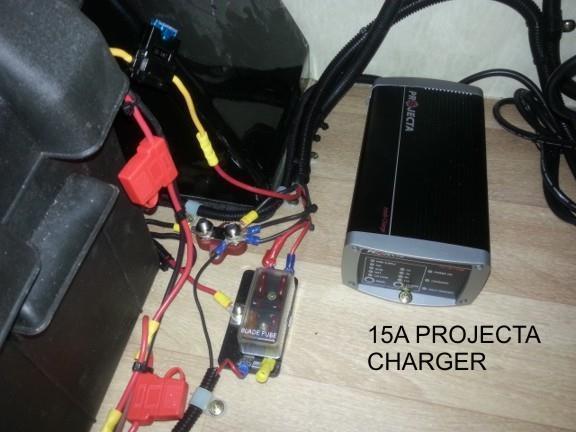condor22
Mike
Some pics of my setup; I'll explain following.





The original equipment was; the battery, a 100AH GEL, the 30A Transformer/Charger, switches for both and the voltmeter. I wasn't happy with the charger side of the transformer. The voltage was only 13.8 and amperage about 5A. Not the best for a GEL (or AGM). This thing also acts as the central distribution point for 12VDC and carries the fuses for the van systems. So a pain to reroute. It also handles the 12 volts to the 3 way fridge, which draws 14A when on 12V. So if only pushing 5amps charge sooner or later the battery will be flat. It also handles an input from the car when connected, but again not the correct voltage. So I figured I'd add a few things to give a better way of charging and more flexibility.
ADDED - Projecta 15A smart charger, Redarc BCDC1220 12v to 12v smart charger, BM Pro battery management device, an exterior double 12v outlet (1 x cig socket and 1 x Merit socket), switch for the Projecta charger, 2 x USB charger port, 4 way fuse block and a negative bus post.
TO ADD - or should I say swap out eventually, replace the 100AH GEL with a 105 or 130AH AGM depending on size.
It's getting late so I'll explain the why and how tomorrow.





The original equipment was; the battery, a 100AH GEL, the 30A Transformer/Charger, switches for both and the voltmeter. I wasn't happy with the charger side of the transformer. The voltage was only 13.8 and amperage about 5A. Not the best for a GEL (or AGM). This thing also acts as the central distribution point for 12VDC and carries the fuses for the van systems. So a pain to reroute. It also handles the 12 volts to the 3 way fridge, which draws 14A when on 12V. So if only pushing 5amps charge sooner or later the battery will be flat. It also handles an input from the car when connected, but again not the correct voltage. So I figured I'd add a few things to give a better way of charging and more flexibility.
ADDED - Projecta 15A smart charger, Redarc BCDC1220 12v to 12v smart charger, BM Pro battery management device, an exterior double 12v outlet (1 x cig socket and 1 x Merit socket), switch for the Projecta charger, 2 x USB charger port, 4 way fuse block and a negative bus post.
TO ADD - or should I say swap out eventually, replace the 100AH GEL with a 105 or 130AH AGM depending on size.
It's getting late so I'll explain the why and how tomorrow.





